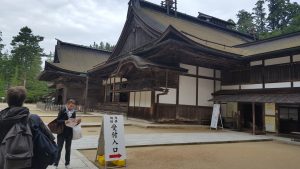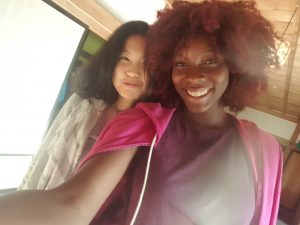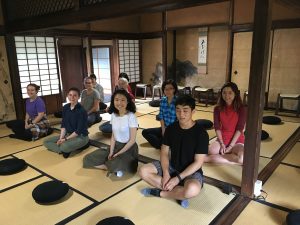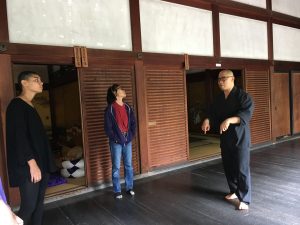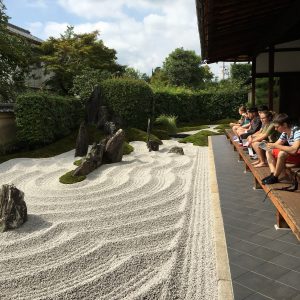As I write this (Friday) we are on the bus leaving Kumano for Kyoto. In the interest of preserving my tablet’s battery life for the several hours of hiking and travel ahead, I’m drafting on paper, which is difficult because of the bus’s constant rocking and shuddering on these narrow roads and also because of the very distracting view outside the window. I think this must be the most beautiful place I have ever seen. Japan isn’t a big country, so I don’t understand how these trees and hills can stretch on for so long. Compact clusters of houses, inns, gardens, cemetaries, post offices, shrines, rice paddies, swimming pools, and convenience stores are snug against the apparently unharmed pine forests. I didn’t know there were still places where things coexisted like this. On the ride in, people swore in excitement and jostled for pictures as we passed massive man-made waterfalls and pipelines running down the side of the ridge, and then the bus fell silent except for the sounds of camera shutters. Again and again the hillside hugs the road, then falls away, and the Kumano River swings into view. I’ve been told water actually is blue, but I feel like this is the first time I’ve seen an actually blue river.
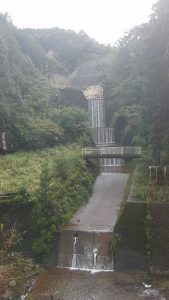
There’s just so much here. I see two derelict trucks abandoned side by side, the undergrowth beginning to invade them. A rusty bridge spans a small ravine; the footpath it was once a part of is long gone. A brown furry creature the size of a large dog crosses a road far below, and another follows a moment later. A pipe sticks out of the cliff trickling water into a small square basin. Far above, fog hangs in the highest treetops as if some clouds came down from on high and got snagged there. I’m snagged here. I can’t look away. I’m not quite in an ecstasy, but I am in a kind of wonder-fatigue. I recall a reading from Professor Schulz’s class in which Jon Kabat-Zinn discusses observing as a facet of mindfulness: experiencing (for example) a sunset by simply noticing it in the present moment. If you allow your awareness to be filled with thoughts, feelings, and memories, you have lost the sunset right in front of you. You are only seeing your idea of a sunset or your recollections of other sunsets you have seen in the past. At times I tried to “simply observe” Kumano, but it seemed impossible to drink this place in without being swept away by a stream of questions and yearnings. In truth, I wanted to be swept away. I knew I couldn’t come to know this place and it’s people with their lifetimes full of stories. I couldn’t “lose” it, never having found it, but what I could do was lose myself in the mystery for as long as I was here.
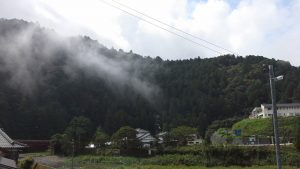
The morning after we arrived in Kumano, we were back on the bus, on our way to visit a man named Tateishi Kosho. Kosho is a yamabushi, a hermit in the mountain ascetic religion of Shugendo. Our professors had described him to us as “a character” and “a charismatic figure,” but I was not prepared for the sudden change in the atmosphere when he climbed onboard our bus, full of smiles and enthusiasm. Dressed in simple clothing with Buddhist sutras written across his white jacket, he had a fondness for fist bumps that felt surprisingly unanachronistic. The recent rains made our much-anticipated waterfall hike too dangerous to attempt, but Kosho didn’t seem too fazed. He had already put together an alternative itinerary for us. Minutes later, we were getting off the bus and making our way towards a small cottage overlooking the river. This turned out to be the house of one of Kosho’s friends, and he had not been forewarned of our visit at all (in fact, he had just woken up). He didn’t say much while we were there; he simply sat in front of the giant flat-screen TV that dominated his otherwise simple house while Kosho gathered us around the open back door. Years ago, Kosho explained as Professor Glassman translated for us, gravel companies had moved into Kumano. Disregarding every environmental regulation on the books (these were scary folks, possibly tied to organized crime), they carved into the mountains, harvesting rock to grind into bits. Kosho refused to sit quietly as the sacred land was polluted. He and several other yamabuchi went out to the forest playing their conch shell trumpets, summoning the deities of earth and water to aid them in the fight against the companies. From the porch where we stood, Kosho gestured towards the distant hills. At one time, he told us, they had been peppered with dozens of gravel-making machines. Now, although the land was still scarred, there was only one machine left, a dilapidated structure dwarfed by the surrounding trees. Spiritual warfare, I thought. I didn’t quite understand the method, and I wasn’t sure if I was getting the full story, but there was no denying the outcome: Kosho had won the battle.
Later that day, Kosho and his wife made us a tasty lunch of dumplings and noodles with broth. He set out a small plate of limes to squeeze into our soup, which I was very happy about. When he heard me ask my tablemates if there were any extra limes, he remarked, “Oh, you really like those, huh?” and disappeared for a minute into his kitchen, then reemerged with an entire box of limes, which he set on the table near me. As the meal was drawing to a close and I was drinking the last of my broth (now with six lime halves floating in it), the professors passed out wooden sticks on which we were each instructed to write a wish or prayer for Kosho’s fire ceremony. When had all gathered in the shrine next to Kosho’s house, Professor Glassman and Professor Schulz sat on either side of the altar and read the sticks out loud, then placed them in the fire, which signified the mouth of the god Fudo-Myoo. Most of my classmates requested things like good health for their families or happiness for all people, so I felt a little embarrassed when Professor Glassman read my wish, which was a little more concrete and perhaps a little more selfish: “I wish to live somewhere as beautiful as Kumano someday.”

